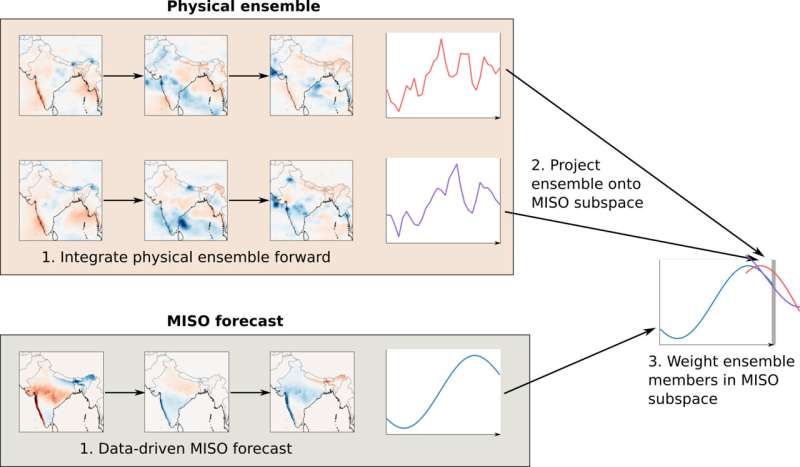
A simplified diagram of the EnOC algorithm, with two dynamical ensemble members for simplicity. Here, the second (purple) ensemble member will receive a higher weight, since it is closer to the MISO forecast in the subspace. Note that in the real implementation, we reduce the dynamics in the MISO subspace to the first two principal components of the MISO mode. Credit: Proceedings of the National Academy of Sciences (2024). DOI: 10.1073/pnas.2312573121
Every year, the South Asian monsoon season brings heavy rain to over a billion people in the Indian subcontinent between June and September. The rain falls in oscillations: Some weeks see 1 to 4 inches of water, while other weeks are mostly dry. Predicting when these dry and wet periods will occur is critical for agricultural and urban planning, enabling farmers to know when to harvest crops and helping city officials prepare for flooding. However, while weather predictions are mostly accurate within one or two days, precisely predicting the weather a week or month out is very difficult.
Now, a new machine-learning-based forecast has been shown to more accurately predict the South Asian monsoon rainfall 10 to 30 days in advance, a significant improvement on current state-of-the-art forecasts that use numerical modeling rather than artificial intelligence to make predictions. Understanding monsoon behavior is also important because this type of rainfall is a major atmospheric feature in the global climate.
The research was led by Eviatar Bach, the Foster and Coco Stanback Postdoctoral Scholar Research Associate in Environmental Science and Engineering, who works in the laboratories of Tapio Schneider, the Theodore Y. Wu Professor of Environmental Science and Engineering and JPL senior research scientist; and Andrew Stuart, the Bren Professor of Computing and Mathematical Sciences.
A paper describing the new method appears in the Proceedings of the National Academy of Sciences.
“There is a lot of concern about how climate change will affect the monsoon and other weather events like hurricanes, heat waves, and so on,” Bach says. “Improving predictions on shorter timescales is an important part of responding to climate change because we need to be able to improve preparedness for these events.”
A model of how monsoon rainfall varies, called the “monsoon intraseasonal oscillation,” over the Indian subcontinent throughout a single season. Credit: E. Bach
Predicting the weather is difficult because the atmosphere contains numerous instabilities—for example, the atmosphere is continually heated from the earth below, leading to cold, denser air above hotter, less dense air—as well as instability caused by uneven heating and Earth’s rotation. These instabilities lead to a chaotic situation in which the errors and uncertainties in modeling the atmosphere’s behavior quickly multiply, making it nearly impossible to predict further into the future.
Current state-of-the-art models use numerical modeling, which are computer simulations of the atmosphere based on the physics equations describing the motion of fluids. Because of chaos, the maximum predictable time for large-scale weather is usually around 10 days. Predicting the long-time average behavior of the atmosphere—that is, the climate—is also possible, but predicting the weather in the time interval between two weeks to several months has been a challenge with numerical models.
With South Asian monsoons, rain tends to fall in cycles of intense bursts followed by dry spells. These cycles are known as monsoon intraseasonal oscillations (MISOs). In the new research, Bach and his collaborators added a machine-learning component to current state-of-the-art numerical models. This allowed the researchers to gather data about the MISOs and make better predictions of the rainfall on the elusive two-to-four-week timescale. The resulting model was able improve the correlations of the predictions with observations by up to 70%.
“In the past few years, there has been an increased interest in using machine learning for weather prediction,” Bach says. “Our work shows that a combination of machine learning and more traditional numerical modeling can produce accurate results.”
The paper is titled “Improved subseasonal prediction of South Asian monsoon rainfall using data-driven forecasts of oscillatory modes.” In addition to Bach, co-authors are V. Krishnamurthy and Jagadish Shukla of George Mason University; Safa Mote of Portland State University; A. Surjalal Sharma and Eugenia Kalnay of the University of Maryland; and Michael Ghil of École Normale Supérieure in Paris, UCLA, and Imperial College London.
More information:
Eviatar Bach et al, Improved subseasonal prediction of South Asian monsoon rainfall using data-driven forecasts of oscillatory modes, Proceedings of the National Academy of Sciences (2024). DOI: 10.1073/pnas.2312573121
Citation:
AI improves monsoon rainfall predictions (2024, April 1)
retrieved 2 April 2024
from https://phys.org/news/2024-04-ai-monsoon-rainfall.html
This document is subject to copyright. Apart from any fair dealing for the purpose of private study or research, no
part may be reproduced without the written permission. The content is provided for information purposes only.
>>> Read full article>>>
Copyright for syndicated content belongs to the linked Source : Phys.org – https://phys.org/news/2024-04-ai-monsoon-rainfall.html































